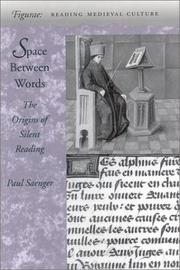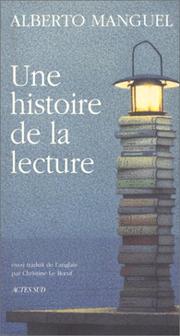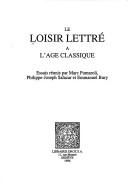| Listing 1 - 10 of 30 | << page >> |
Sort by
|
Book
ISBN: 9782406090670 9782812454332 2812454334 2406090671 Year: 2019 Volume: 47 Publisher: Paris: Classiques Garnier,
Abstract | Keywords | Export | Availability | Bookmark
 Loading...
Loading...Choose an application
- Reference Manager
- EndNote
- RefWorks (Direct export to RefWorks)
Etude et circuit du livre à la Renaissance : fabrication, diffusion et changement des habitudes de lecture lié à l'apparition de l'imprimé. En même temps qu'il accroît considérablement la diffusion du savoir, il transforme, par sa présentation même, les conditions de production et de réception du texte.
Book
ISBN: 9782812425424 2812425423 9782812425431 2812425431 Year: 2014 Volume: 3 7 Publisher: Paris : Belles Lettres,
Abstract | Keywords | Export | Availability | Bookmark
 Loading...
Loading...Choose an application
- Reference Manager
- EndNote
- RefWorks (Direct export to RefWorks)
Fiction --- anno 1800-1999 --- Books and reading in literature --- Women --- Women in literature --- European fiction --- Books and reading --- History --- History and criticism --- Women - Books and reading - History - 19th century --- Women - Books and reading - History - 20th century --- European fiction - 19th century - History and criticism --- European fiction - 20th century - History and criticism

ISBN: 0804726531 080474016X 9780804740166 9780804726535 Year: 1997 Volume: *7 Publisher: Stanford: Stanford university press,
Abstract | Keywords | Export | Availability | Bookmark
 Loading...
Loading...Choose an application
- Reference Manager
- EndNote
- RefWorks (Direct export to RefWorks)
Sociology of culture --- anno 500-1499 --- Books and reading --- Silent reading --- Writing --- Livres et lecture --- Lecture silencieuse --- Ecriture --- History --- Histoire --- 028 --- 091 --- 02 "04/14" --- -Silent reading --- -Reading --- Appraisal of books --- Books --- Choice of books --- Evaluation of literature --- Literature --- Reading, Choice of --- Reading and books --- Reading habits --- Reading public --- Reading --- Reading interests --- Reading promotion --- Lezen. Lectuur --- Handschriftenkunde. Handschriftencatalogi --- Bibliotheekwezen: Middeleeuwen --- Appraisal --- Evaluation --- History. --- -Lezen. Lectuur --- 02 "04/14" Bibliotheekwezen: Middeleeuwen --- 091 Handschriftenkunde. Handschriftencatalogi --- 028 Lezen. Lectuur --- -02 "04/14" Bibliotheekwezen: Middeleeuwen --- -Appraisal of books --- Silent reading - History. --- Books and reading - History --- Silent reading - History
Book
ISSN: 2103480X ISBN: 9782406068266 9782406068273 2406068269 Year: 2019 Volume: 60 5 Publisher: Paris: Classiques Garnier,
Abstract | Keywords | Export | Availability | Bookmark
 Loading...
Loading...Choose an application
- Reference Manager
- EndNote
- RefWorks (Direct export to RefWorks)
Pourquoi les lecteurs ont-ils abandonné la lecture d’Amadis de Gaule, L’Astrée ou Clélie alors qu’ils sont attachés aux romans de Cervantès, Madame de Lafayette, Prévost ou Diderot ? Cet ouvrage répond à cette question en adoptant le point de vue des lecteurs passionnés pour les secrets des fictions romanesques.
Fiction --- Psychological study of literature --- anno 1500-1799 --- French fiction --- European fiction --- Secrecy in literature --- Books and reading --- Appreciation --- History --- French fiction - Appreciation --- European fiction - Appreciation --- Books and reading - History

ISBN: 2742715436 9782742715435 Year: 1998 Publisher: Arles: Actes Sud,
Abstract | Keywords | Export | Availability | Bookmark
 Loading...
Loading...Choose an application
- Reference Manager
- EndNote
- RefWorks (Direct export to RefWorks)
Book history --- Books and reading --- Livres et lecture --- History --- Histoire --- 82.085.43 --- 028 --- 930.85:02 --- Literaire receptie --- Lezen. Lectuur --- Cultuurgeschiedenis. Kultuurgeschiedenis-:-Bibliotheekwezen --- 930.85:02 Cultuurgeschiedenis. Kultuurgeschiedenis-:-Bibliotheekwezen --- 028 Lezen. Lectuur --- 82.085.43 Literaire receptie --- 820 --- lecture --- letterkunde --- littérature --- Books and reading - History --- #X-L: Casterman --- Lecture

ISBN: 2600001751 9782600001755 Year: 1996 Volume: 4 Publisher: Genève: Droz,
Abstract | Keywords | Export | Availability | Bookmark
 Loading...
Loading...Choose an application
- Reference Manager
- EndNote
- RefWorks (Direct export to RefWorks)
Thematology --- French literature --- anno 1600-1699 --- Leisure --- Books and reading --- Intellectual life --- Seventeenth century --- Social aspects --- History --- Congresses. --- Leisure in literature. --- History and criticism. --- Leisure - Social aspects - History - 17th century - Congresses. --- Books and reading - History - 17th century - Congresses. --- Intellectual life - History - 17th century - Congresses. --- Seventeenth century - Congresses.
Book
ISBN: 9782600017671 2600017674 Year: 2014 Volume: 119 Publisher: Genève: Droz,
Abstract | Keywords | Export | Availability | Bookmark
 Loading...
Loading...Choose an application
- Reference Manager
- EndNote
- RefWorks (Direct export to RefWorks)
L’opinion selon laquelle la Renaissance a vu la transformation des sociétés européennes en cultures de l’imprimé a eu un immense impact sur les études littéraires, historiques, philosophiques et bibliographiques portant sur cette période. Cependant, le concept de culture de l’imprimé a récemment été discuté, voire ébranlé, par des analyses qui ont souligné la permanence de la culture du manuscrit au-delà du XVe siècle, ont conduit à relativiser la primauté des avancées technologiques sur d’autres dynamiques culturelles et identifié la présence, avant l’ère de l’imprimé, d’innovations qui lui sont habituellement attribuées. Le présent livre s’attache à discuter ces nouveaux aspects de la culture de l’imprimé, c’est-à-dire à affiner et à redéfinir notre compréhension des cultures de l’imprimé, du XVe à la fin du XVIIe siècle. Quel rôle ont joué les nouvelles figures de médiateur dans la définition du processus éditorial ? Comment affirmer l’existence d’une culture de l’imprimé en dépit de la persistance de la circulation des manuscrits, tant dans la sphère privée que commerciale ? Quelle place prend alors l’oralité dans un monde apparemment dominé par les textes imprimés ?
Printing --- Editing --- Imprimerie --- Edition --- History --- Histoire --- Europe --- Intellectual life --- Vie intellectuelle --- Books and reading --- Civilization --- Édition --- Histoire. --- History. --- Civilization. --- Printing - History --- Books and reading - History --- Europe - Civilization --- Édition --- Book history --- printing plants --- book history --- anno 1400-1499 --- anno 1500-1599 --- anno 1600-1699
Book
ISBN: 9782406093145 9782406093152 240609314X 2406093158 Year: 2019 Volume: 416 36 Publisher: Paris : Classiques Garnier,
Abstract | Keywords | Export | Availability | Bookmark
 Loading...
Loading...Choose an application
- Reference Manager
- EndNote
- RefWorks (Direct export to RefWorks)
"Ce volume rassemble les articles issus du colloque "Aspects sociaux des littératures médiévales : texte et situation communicative au Moyen Âge". Les chercheurs se concentrent sur l'étude des formes diverses de l'interaction entre l'écrivain, son texte, les communautés des lecteurs contemporains auxquelles il s'adresse et ses lecteurs postérieurs. Ces articles permettent de signaler les oeuvres qui contiennent les informations sur les "lecteurs théoriques", visés par l'auteur. Ils aident à systématiser, de plus, les données sur les communautés des lecteurs qui, au Moyen Âge, définissaient les particularités de la réception."-- Back cover
Littérature médiévale --- Relations écrivains-lecteurs --- Littérature française --- Aspect social --- Appréciation --- Aspect social. --- Communication in literature --- Books and reading --- Authors and readers --- Literature, Medieval --- History --- Social aspects --- Appreciation --- Sociology of literature --- Old French literature --- Appréciation --- Communication in literature - Congresses --- Books and reading - History - To 1500 - Congresses --- Authors and readers - History - To 1500 - Congresses --- Literature, Medieval - Social aspects - Congresses --- Literature, Medieval - Appreciation - Congresses

ISBN: 0748402861 9780748402861 Year: 1995 Volume: *2 Publisher: London: Taylor & Francis,
Abstract | Keywords | Export | Availability | Bookmark
 Loading...
Loading...Choose an application
- Reference Manager
- EndNote
- RefWorks (Direct export to RefWorks)
Age group sociology --- Journalism --- anno 1900-1999 --- Great Britain --- Children's periodicals, English --- Youth's periodicals --- Girls --- History --- Books and reading --- Youth's periodicals, English --- English children's periodicals --- English periodicals --- Children's periodicals [English ] --- 20th century --- Children's periodicals, English - History - 20th century. --- Youth's periodicals - Great Britain - History - 20th century. --- Girls - Great Britain - Books and reading - History - 20th century. --- Girls - Books and reading - Great Britain - History - 20th century.
Book
ISBN: 9782503545691 9782503547411 2503545696 Year: 2013 Volume: 25 Publisher: Turnhout: Brepols,
Abstract | Keywords | Export | Availability | Bookmark
 Loading...
Loading...Choose an application
- Reference Manager
- EndNote
- RefWorks (Direct export to RefWorks)
"Read often, learn all that you can. Let sleep overcome you, the roll still in your hands; when your head falls, let it be on the sacred page." (St Jerome, 384 AD). With these words, the Church Father Jerome exhorted the young Eustochium to find on the sacred page the spiritual nourishment that would give her the strength to live a life of chastity and to keep her monastic vows. His call to read does not stand alone. Books and reading have always played a pivotal role in early and medieval Christianity, often defined as ‘a religion of the book’.A second important stage in the development of the ‘religion of the book’ can be attested in the late Middle Ages, when religious reading was no longer the exclusive right of men and women living in solitude and concentrating on prayer and meditation. Changes in the religious landscape and the birth of new religious movements transformed the medieval town into a privileged area of religious activity. Increasing literacy opened the door to a new and wider public of lay readers. This seminal transformation in the late medieval cultural horizon saw the growing importance of the vernacular, the cultural and religious emancipation of the laity, and the increasing participation of lay people in religious life and activities.This volume presents a new, interdisciplinary approach to religious reading and reading techniques in a lay environment within late medieval textual, social, and cultural transformations.
Literature --- Religious studies --- anno 500-1499 --- Religion and religious literature --- Religious literature --- Laity --- Religion et littérature religieuse --- Littérature religieuse --- Laïcat --- History --- Distribution --- Books and reading --- Histoire --- Diffusion --- Livres et lecture --- 248 "04/14" --- Spiritualiteit. Ascese. Mystiek. Vroomheid--Middeleeuwen --- Religion et littérature religieuse --- Littérature religieuse --- Laïcat --- To 1500 --- Religieuze literatuur--Verspreiding --- Religion and religious literature - History - To 1500 --- Religious literature - Distribution - History - To 1500 --- Laity - Books and reading - History - To 1500 --- Bible as literature
| Listing 1 - 10 of 30 | << page >> |
Sort by
|

 Search
Search Feedback
Feedback About UniCat
About UniCat  Help
Help News
News